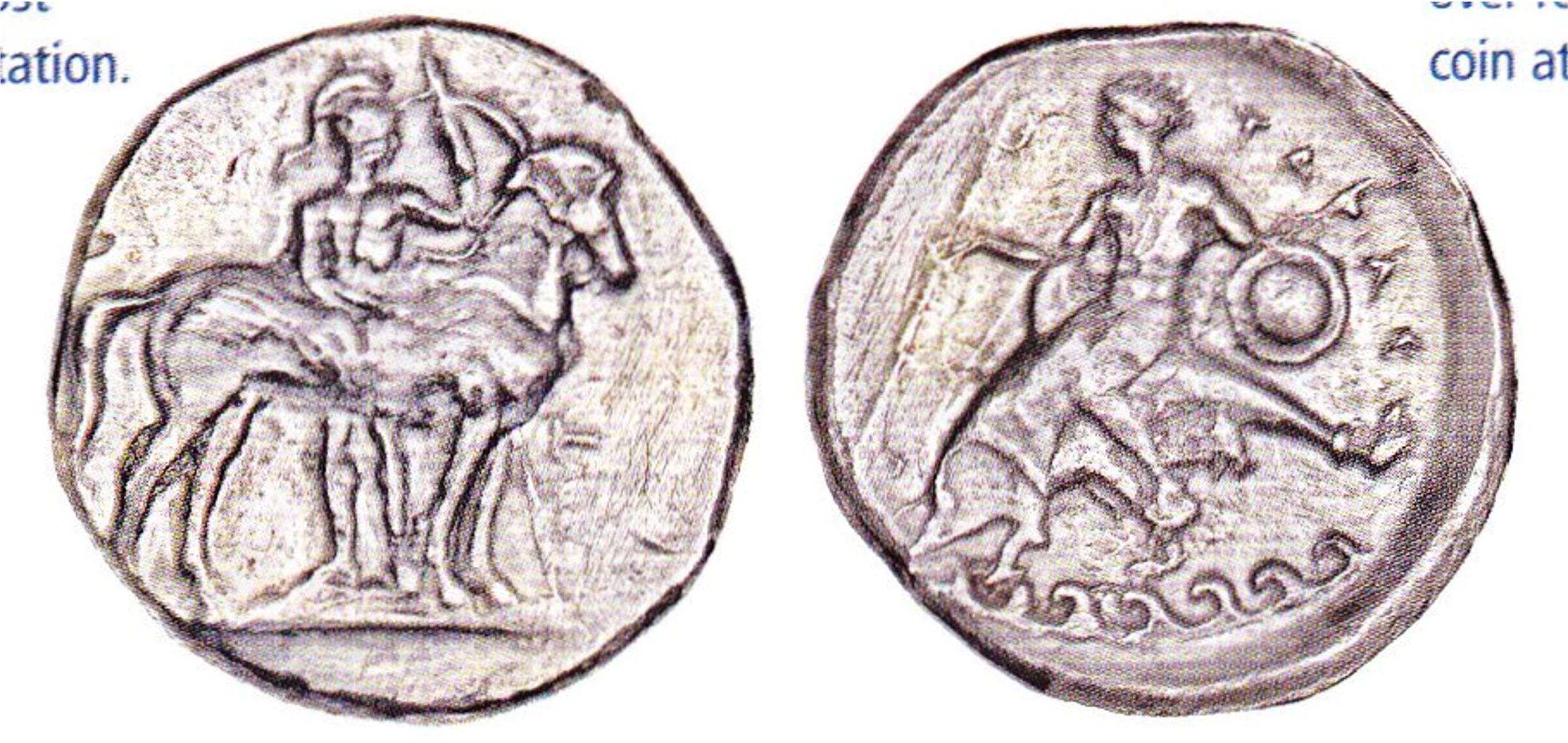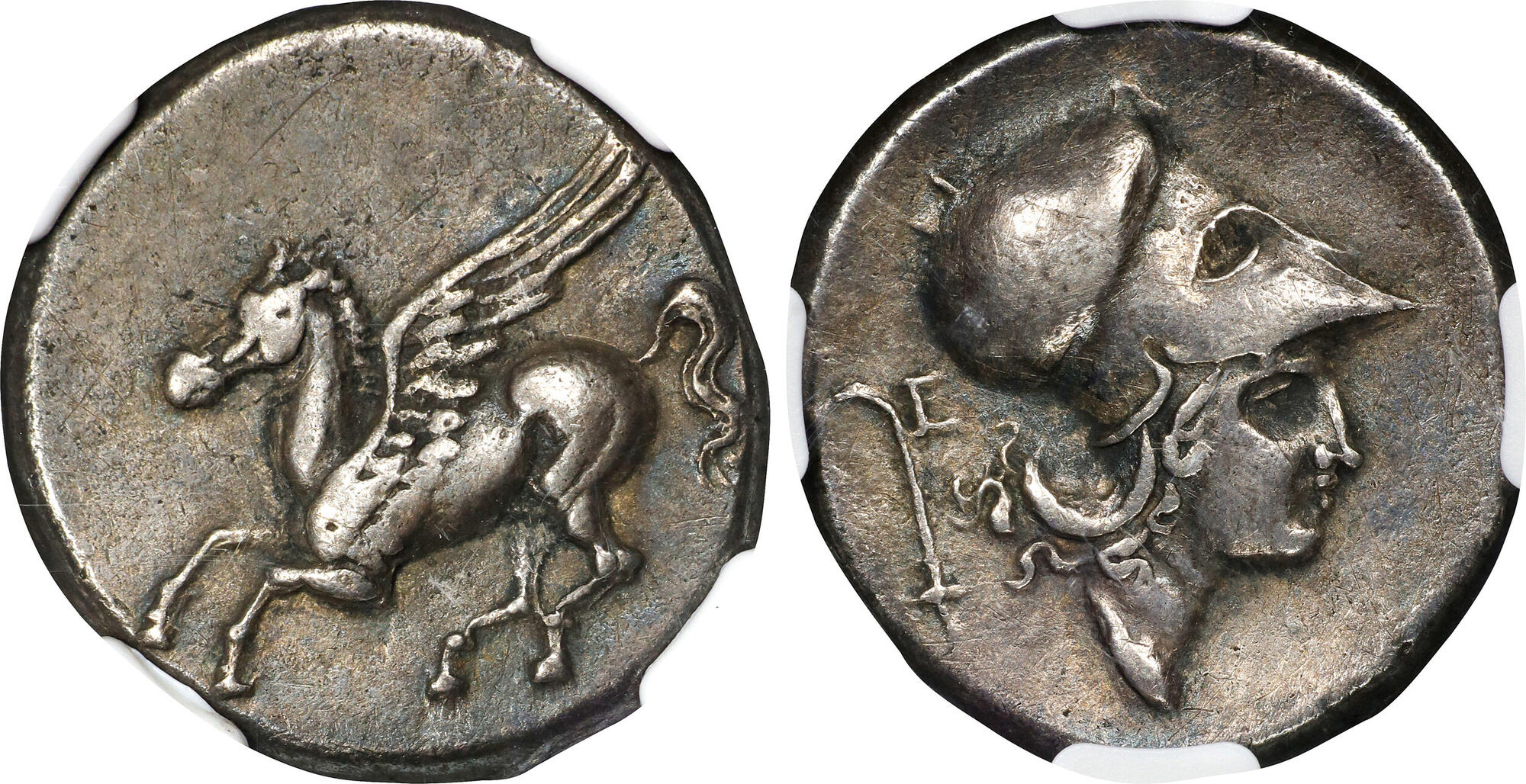345 BCE - 340 BCE | TAPAΣ
Overstriking coin
SO 1355 - Taras over Echinus.jpg
[1]
Overstruck variety
Echinus Pegasus Athena 560 BCE.jpeg
[2]
1355 Echinus Corinthian-type (drawing).jpg
|
|
Sale(s)Sale(s) ᵖ:
|
Sotheby's, L, 26 July 1920, 5 = Glendining, 25 Oct. 1955 (Lockett sale), 146 = Classical Numimatic Group, 50, 23 June 1999, 411
|
| Private collection(s)Private collection(s) ᵖ:
|
Lockett coll., n° 146; David MacDonald collection, n° 10
|
|
Description
| ObverseInscription or printing placed on the obverse.:
|
Horse right, behind him which stands warrior, nude, wearing helmet, to front, head right, holding spearand shield. In right field, sideways T. (Fields have been smoothed in modern times, presumably to eliminate traces of the host coin).
|
ReverseInscription or printing placed on the reverse.:
|
TAPAΣ (Greek) Male character (Taras or Phalanthos), nude, seated sideways on dolphin left, holding trident and shield. Below, A.
|
Mint and issuing power
| MintIdentifies the place of manufacture or issue of a numismatic object.:
|
Taras
|
Ancient regionAncient region.
|
Calabria
|
Modern countryModern country: Italy
|
AuthorityIdentifies the issuing power. The authority can be "pretended" when the name or the portrait of X is on the coin but he/she was not the issuing power. It can also be "uncertain" when there is no mention of X on the coin but he/she was the issuing power according to the historical sources:
|
|
Chronology
| FromIdentifies the initial date in a range assigned in a numismatic context. 345 BCE toIdentifies the final date in a range assigned in a numismatic context.. 340 BCE
|
Classical 480-323 BC  periodTime period of the numismatic object. periodTime period of the numismatic object.
|
Physical description
MetalThe physical material (usually metal) from which an object is made.: Silver 
|
WeightWeight of the numismatic object (in grams). in grams: 7.477.47 g <br />7,470 mg <br />
|
DenominationTerm indicating the value of a numismatic object. Examples: tetradrachm, chalkous, denarius.: nomos
|
AxisDescribes the directional relationship between the obverse and reverse of a numismatic object.: 22 mm <br />0.2 cm <br />
|
|
|
|
References
| Coin referenceReference of the Coin:
|
Noe 1957, p. 32, Group VII.1, pl. XI.I, Garraffo 1984, n° 57a, pl. 3.2, Calciati 1990, vol. 2, p. 652, n° 55, Fischer-Bossert 1999, group 48, n° 684 I (V259/R531), MacDonald 2009, p. 17, n° 10
|
Coin series referenceReference to coin series study:
|
Noe 19571Noe 1957, p. 32, Group VII.1, pl. XI.I, Garraffo 19842Garraffo 1984, n° 57a, pl. 3.2, Calciati 19903Calciati 1990, vol. 2, p. 652, n° 55, Fischer-Bossert 19994Fischer-Bossert 1999, group 48, n° 684 I (V259/R531), MacDonald 20095MacDonald 2009, p. 17, n° 10, HGC 16HGC 1, n° 787
|
| Coin series web referenceCoin series web references:
|
|
Description
| ObverseInscription or printing placed on the obverse.:
|
Pegasus left (visible: portion of Pegasus's wing, torso, back of front leg, other vague traces)
|
ReverseInscription or printing placed on the reverse.:
|
Head of Aphrodite right, wearing Corinthian helmet. Behind, hook and E (visible: traces of Aphrodite's head and clearly preserved hook and portion of E)
|
Mint and issuing power
| MintIdentifies the place of manufacture or issue of a numismatic object. ᵖ:
|
Echinus
|
Ancient regionAncient region. ᵖ
|
Acarnania
|
Modern countryModern country: Greece
|
AuthorityIdentifies the authority in whose name (explicitly or implicitly) a numismatic object was issued. ᵖ:
|
|
Chronology
| FromIdentifies the initial date in a range assigned in a numismatic context. 400 BCE toIdentifies the final date in a range assigned in a numismatic context.. 340 BCE
|
Classical 480-323 BC  periodTime period of the numismatic object. periodTime period of the numismatic object.
|
Physical description
| DenominationTerm indicating the value of a numismatic object. Examples: tetradrachm, chalkous, denarius. ᵖ:
|
stater 
|
|
|
References
References
- ^ Noe, Sydney P. (1957), "Overstrikes in Magna Graecia", American Numismatic Society. Museum Notes 7, p. 13-42, pl. 5-14.
- ^ Garraffo, Salvatore (1984), Le riconiazioni in Magna Grecia e in Sicilia. Emissioni argentee dal VI al IV secolo a.C., Catania.
- a b Calciati, Romolo (1990), Pegasi, Mortara, Edizioni I.P..
- ^ Fischer-Bossert, Wolfgang (1999), Chronologie der Didrachmenprägung von Tarent, 510-280 v. Chr., Berlin, De Gruyter, xvii, 495 p., [84] pl.
- ^ Macdonald, David (2009), Overstruck Greek coins: studies in Greek chronology and monetary theory, Whitman Publishing, Atlanta.
- ^ Hoover, Oliver D. (2018), The Handbook of Greek Coinage Series, Volume 1. Handbook of Coins of Italy and Magna Graecia, Sixth to First Centuries BC., Lancaster-London, 2018, lxi, 527 pages, 23 cm


